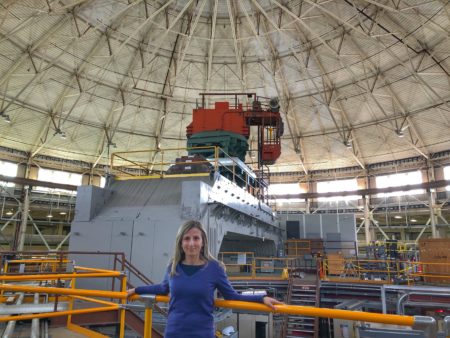 As the lead radiation physicist at the ALS, Stefania Trovati is an expert in characterizing the radiation environment, but her expertise stretches beyond physics. She is also highly knowledgeable about raccoons and many other animals.
As the lead radiation physicist at the ALS, Stefania Trovati is an expert in characterizing the radiation environment, but her expertise stretches beyond physics. She is also highly knowledgeable about raccoons and many other animals.
What does your work entail?
I work for both the ALS and the ALS-U Project. My job consists of supporting the safe design and operation of the accelerator and the beamlines. I conduct studies to characterize the radiation environment at the facility for present and for future operations, using computer simulations and performing measurements. Once I have understood the radiation fields and their hazards, I can support the design of mitigation measures, such as shielding and beam interlocks.
What led you here to the ALS?
It started a long time ago. I was a physics student. I took my masters and then I wanted to do a PhD, but I wasn’t quite sure which physics specialty I wanted to do. I took a small grant for a few months to do biophysics research, and it was interesting, but in the end I went into medical physics—experimental radio-biology and also a bit of modeling and simulations for a new hadron-therapy center in Italy.
From that, I got a Marie Curie Fellowship and moved to CERN. I did my fellowship there and started doing more radiation physics for particle accelerators. So that’s where I really started with what I’m presently doing. After CERN, I moved to the national lab of Switzerland, the Paul Scherrer Institute, where I worked for both the medical physics and the radiation protection groups. When I came to the US I was first at Stanford in the Radiation Physics group of the Radiation Oncology Department, then in the Radiation Physics group at SLAC, and now I’m at the ALS. I’ve always been doing radiation physics for particle accelerators, including those used for radiotherapy. In medical physics the job of a radiation physicist is to optimize how the radiation is delivered to the patient, while what I’m doing here is to keep radiation away from people, but the methods and tools are the same. The methods that radiation physicists use have changed over time because our knowledge of how radiation interacts with the accelerator components has improved. We have also developed more and more computational tools, so instead of using only analytical calculations, we do more Monte Carlo type of studies, which are as close as it gets to a real experiment.
Here at the ALS I like to be in the inception phase of a new project so that I can make a significant contribution and also try to shape it a bit. It’s very exciting and challenging: the floor space at the ALS is not large, so one has to use, beside calculations, some imagination!
Is there anything about you that we might find surprising?
My plan is to get a house with some land to start my never-to-table farm. I have two cats, but they live indoors, so I’m dreaming about giving them a better place to live. I think I can manage goats, dogs, cats, and rabbits. I love all animals; I was a volunteer at the Peninsula Humane Society, where I fed baby raccoons and squirrels. It was rather busy during spring season: hundreds of baby squirrels to feed. In the beginning of my training, I could feed two at a time with syringes, but the experienced staff could feed four at a time, two syringes in each hand!
What do you do in your free time?
If I had talent, I would be a rock star, but I just do some baking instead—bread and cakes, everything from classic Italian cakes to naked cakes. I tried baking macarons using recipes from the web, and it was always a disaster, so I took a class, and it was life changing. Every French recipe is a lot of work! But I love French food. It has to be said that I was not always into fancy French food: when I was a student, and lived in Paris for a year, I never spent much money on food, I was more hungry for experiences. Luckily, I lived right at the end of the Boulevard Saint-Michel in the Latin Quarter, where there were a lot of art exhibition openings with free food. And so, together with some friends we were just pretending to be very interested in art, going to check out the paintings and get some food for free.
Lastly, how is your family doing during this pandemic?
I grew up in a small village, where my parents still live. It’s in Northern Italy, which is now the hot zone for the pandemic. They’re okay, but of course, I worry. They live in a small community, where, even while keeping social distances, everyone supports everyone.